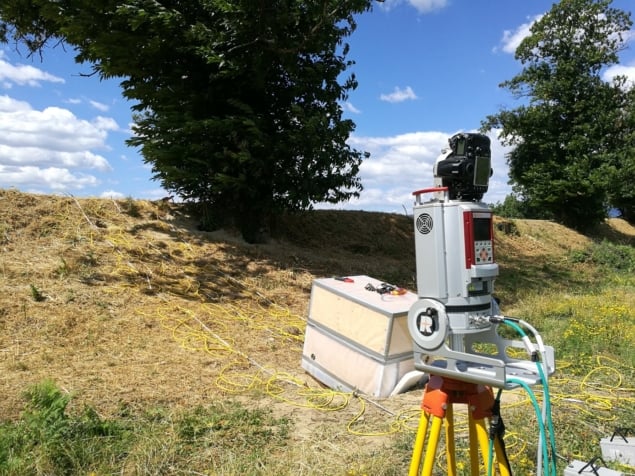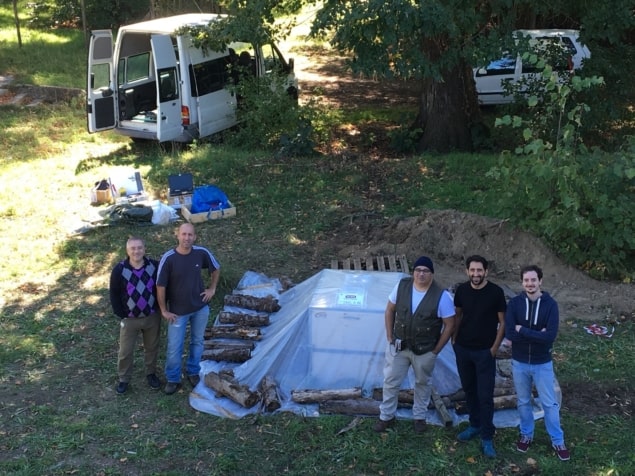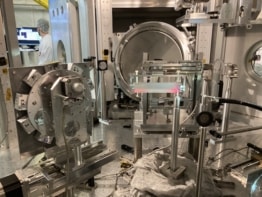
In 2017 the ScanPyramids collaboration discovered a hidden chamber inside Khufu’s Pyramid at Giza in Egypt using muon radiography. Now, scientists have employed this technique to check for rodent burrows in Italian river embankments.
“At the moment every evaluation of flooding …[is] estimated only on the possibility of overflow, considering the banks intact and completely stable from a structural point of view,” says Veronica Pazzi of the University of Florence, Italy. “However, chronicles sometimes contradict this widespread claim, reporting inundations after a structure’s collapse.”

Muons reveal hidden void in Egyptian pyramid
Using muon radiography alongside existing survey techniques could reconstruct voids inside embankments in 3-D. That should help engineers analyse the stability of such levees and the risk of floods from levee piping and collapse.
Muon radiography – or muography – is similar to X-ray radiography. “It exploits natural cosmic-ray muon radiation instead of artificially generated X-rays, and muon trackers – instrumentation commonly used in high energy physics – in place of radiographic plates,” says Lorenzo Bonechi of the University of Florence, Italy.

Cosmic rays from space generate muons in the uppermost layers of Earth’s atmosphere. Like electrons, muons are subatomic particles that are negatively charged, but they’re around 200 times heavier than electrons.
“Depending on their energy, muons can cross from a few metres to hundreds of metres of rock or other materials, being therefore an appropriate tool for the imaging of thick structures, mountains, volcanoes and so on,” says Pazzi.
Banking on the river
Pazzi’s team of physicists, geologists and engineers installed their Muon Imaging for Mining and Archaeology (MIMA) detector on the banks of the river Arno near Florence, Italy, from July to October 2017, and on the Bure embankment near Pistoia in July 2018. They positioned the kit to the side of structurally damaged portions of the levee, and on top to take “free-sky” reference measurements.
The technique imaged the entrance holes of rodents that had burrowed into the embankment, as well as a nearby tree and mountains in the background. The team also took measurements using electrical resistivity tomography (ERT).
Particle-physics lab beneath a Mexican pyramid
At around 1 metre cubed, the MIMA detector is relatively small so needs a long time to form an image; it took three to four weeks to collect 7000 muon counts. Adding to the difficulties, embankments and their rodent burrows are small targets compared to pyramids or volcanoes, and lie near the line of minimum muon flux.
During these trials, the team worked on ways to install the kit under different access and weather conditions. It now takes just over an hour to install MIMA equipment and the system can then take data undisturbed for months.
Geophysical prospects
“Muon radiography is an advanced field of research to try solving problems that are still not easy to solve using traditional techniques, even with the latest technologies,” says Bonechi.
There are still challenges. “Many possible applications can hypothetically profit…but each single case requires special considerations,” says Pazzi. “The feasibility of the measurement depends on many parameters, like the thickness of the object to be studied, its elemental composition, the configuration of the surrounding materials, the line of sight with respect to the muon detector and the size of the anomalies of interest inside.”

Next the team plans to improve the capacity for data acquisition, processing and interpretation. Combining 2D muography images from several viewpoints would enable 3D muography. And lower-cost instrumentation and more user-friendly software “might lead to a real technology transfer towards industry”.
“Physicists…are working together with geologists, geophysicists, archaeologists and engineers, trying to create a common background of knowledge that leads to the adoption of this radiographic method as a standard method of geophysical prospecting,” says Bonechi.
In archaeology, the technique could avoid the use of invasive techniques in highly fragile sites or areas not yet studied, reducing exploration costs and maximizing work times, the researchers say.
“We are already carrying out new studies inside a mining site for the search of pits of Etruscan age which might explain an anomalous penetration of radon in the main gallery,” says Pazzi. “We are also evaluating the possibility to use muon transmission radiography for understanding the internal structure of architectural works. We finally foresee new tests in the field of hydrogeological risk.”
Pyramids and volcanoes
In 2017 another team used muon imaging to discover a void hidden deep within Khufu’s Pyramid at Giza, Egypt. As Physics World reported, this was not the first use of muons to study the interior of pyramids. In the 1960s the American physicist and future Nobel laureate, Luis Alvarez, placed a muon detector in a chamber in the nearby Pyramid of Khafre. He showed that there are no other large chambers in that pyramid.
More recently, Arturo Menchaca of the National Autonomous University of Mexico installed a detector inside the Pyramid of the Sun at Teotihuacan near Mexico City. Physics World‘s James Dacey and Matin Durrani visited the experiment in 2015, where they recorded the podcast “Inside the particle pyramid“. Dacey recounts how the intrepid pair crawled into the interior of the pyramid in “Particle-physics lab beneath a Mexican pyramid“.
Elsewhere in Mexico, a team including Menchaca tried to image the interior of a volcano using muons. See “Monitoring a smoking giant“.
Pazzi reported the riverbank team’s findings at the European Geosciences Union General Assembly in Vienna.



